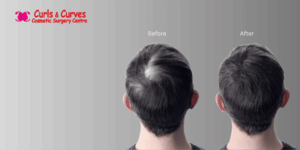Gynecomastia, aka enlarged male breasts, is a common condition affecting many men in India and worldwide. According to a recent report, 76% of men undergoing gynecomastia surgeries (male breast reduction) are between the ages of 21 and 30. This condition, while benign, can cause significant emotional distress and physical discomfort. Gynecomastia occurs when there is an imbalance between testosterone and estrogen, resulting in the growth of breast tissue. Although not life-threatening, understanding the types, causes, symptoms, and treatment options is essential for managing or treating it effectively. This blog is here to help you understand the types of gynecomastia, the potential causes, symptoms, and available gynecomastia treatment options, including surgery.
What is Gynecomastia?
Gynecomastia refers to the enlargement of male breast tissue, often caused by hormonal fluctuations, medication side effects, or underlying health conditions. It can occur during various life stages—infancy, puberty, and old age. While the condition often resolves on its own, persistent or severe cases may require gynecomastia treatment.
Types of Gynecomastia
While all forms of gynecomastia involve the enlargement of male breast tissue, the reasons behind it and its physical characteristics may vary. Here’s a breakdown of the common types:
Physiological Gynecomastia
This type occurs naturally at different stages of life and usually resolves without medical intervention.
- Neonatal Gynecomastia: Many male infants experience temporary breast enlargement due to maternal hormones transferred during pregnancy. This typically resolves within a few weeks.
- Pubertal Gynecomastia: During puberty, hormonal fluctuations can cause temporary breast enlargement in up to 50% of adolescent boys. It often subsides within six months to two years as hormone levels stabilise.
- Adult Gynecomastia: In men over 50, declining testosterone levels and stable estrogen levels may lead to gynecomastia. Factors such as weight gain, medications, or pre-existing health conditions can exacerbate the condition.
Unilateral and Bilateral Gynecomastia
Gynecomastia can affect one or both breasts. The classification into unilateral or bilateral gynecomastia depends on whether one or both breasts are affected. Here’s a closer look:
- Unilateral Gynecomastia: This occurs when one breast enlarges more than the other, making it more noticeable.
- Bilateral Gynecomastia: Both breasts are affected, either symmetrically or asymmetrically.
True Gynecomastia vs. Pseudo-Gynecomastia
Distinguishing between true gynecomastia and pseudo-gynecomastia is important, as the type of tissue involved can affect the treatment approach. Here’s what differentiates them:
- True Gynecomastia: In true gynecomastia, the breast tissue under the nipple enlarges and feels firm. This type may require surgery for long-lasting results.
- Pseudo-Gynecomastia: Pseudo-gynecomastia involves fat accumulation in the chest area rather than breast tissue growth. Liposuction is often the recommended treatment in such cases.
Drug-Induced Gynecomastia
Some medications and drugs can alter hormone levels, leading to gynecomastia. Common culprits include:
- Anabolic steroids (used by bodybuilders)
- Anti-androgens (used to treat prostate cancer)
- Antidepressants
- Alcohol and recreational drugs (like marijuana)
In drug-induced cases, discontinuing the medication can often reverse the condition. However, long-term use may result in permanent breast tissue growth, which may require surgical intervention.
Idiopathic Gynecomastia
In some cases, the cause of gynecomastia remains unknown despite a thorough medical evaluation. This is referred to as idiopathic gynecomastia. Even without a clear cause, treatment options such as male breast reduction surgery are available for men experiencing discomfort or emotional distress.
Symptoms of Gynecomastia
The main symptom of gynecomastia is the enlargement of male breast tissue, which may cause tenderness or discomfort. It’s essential to differentiate between gynecomastia and other conditions like male breast cancer, though the latter is rare. If there is firm or hard tissue, especially on one side, it’s crucial to consult a doctor to rule out other causes.
Treatment Options for Gynecomastia
While many cases of gynecomastia resolve on their own, persistent or serious cases may require medical or surgical intervention. Below are the primary gynecomastia treatment options:
- Medication Adjustments: If medications or drugs are causing the condition, adjusting the dosage or switching to an alternative can reverse gynecomastia. However, if the breast tissue has significantly developed, further treatment may be needed.
- Surgical Treatment: In cases where gynecomastia is severe or long-lasting, surgery is often the recommended option. Male breast reduction surgery, involving liposuction and the removal of excess breast tissue, is a common solution. This procedure restores a more masculine appearance and can greatly improve a person’s confidence.
Gynecomastia Treatment Cost in India
The gynecomastia treatment cost in India depends on various factors, including the severity of the condition, the type of surgery required, and the expertise of the surgeon. On average, the cost of gynecomastia surgery in India ranges from ₹60,000 to ₹1,20,000. This includes consultation fees, surgeon fees, anaesthesia, and hospital charges.
It’s important to consult with a qualified plastic surgeon to get an accurate estimate based on your individual condition and needs.
Struggling with Gynecomastia? Curls & Curves Can Help You Regain Confidence
Are you feeling self-conscious or uncomfortable due to enlarged male breasts? Gynecomastia can have an influential impact on your physical and emotional well-being, but you don’t have to face it alone. At Curls & Curves, we specialise in advanced gynecomastia treatment, offering solutions to help you restore a more masculine appearance and regain your confidence. Whether you’re dealing with true gynecomastia, drug-induced, or idiopathic cases, our team is here to guide you every step of the way. Schedule a consultation with Curls & Curves today and discover how we can help you achieve the results you deserve.





